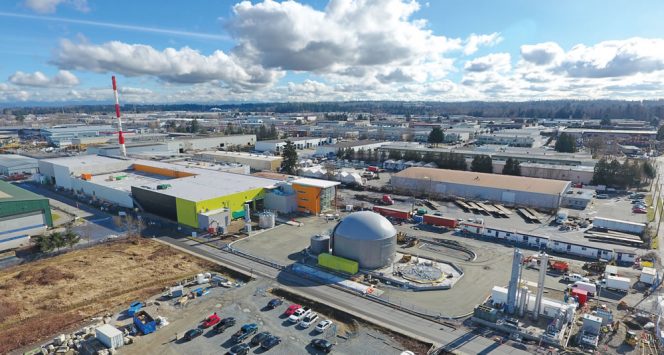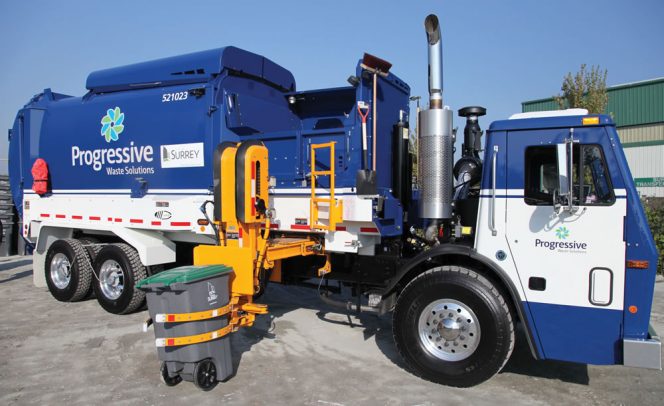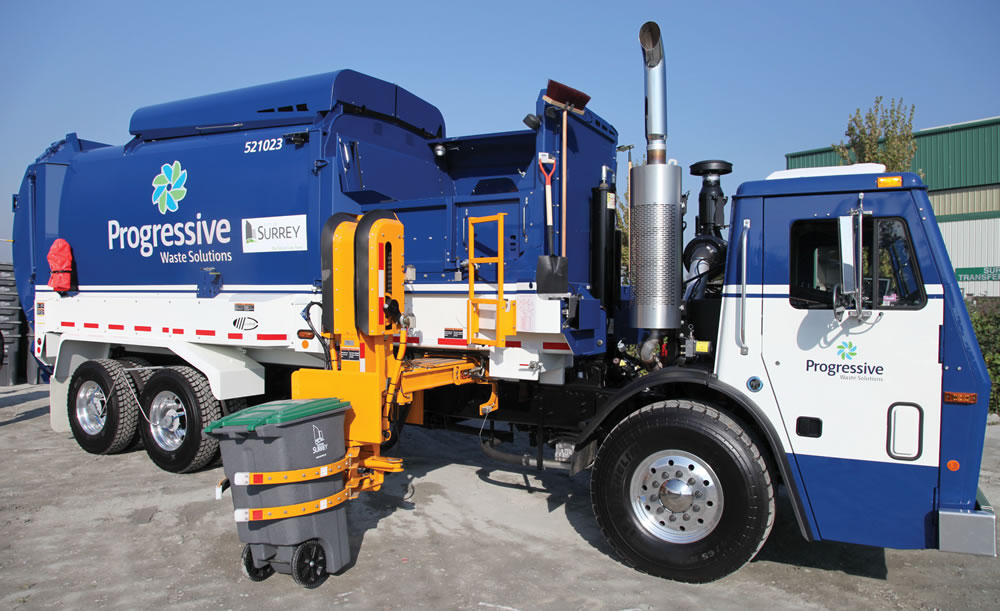The City of Surrey, British Columbia will be opening its 127,000 tons/year food waste and yard trimmings organics recycling operation in June.
Peter Gorrie
BioCycle May 2017

The Surrey Biofuel Facility has capacity to process 127,000 tons/year of source separated residential and commercial organics. Photo by Ryan Lauzon, Orgaworld
Surrey is a suburban city of nearly 520,000 within the Metro Vancouver Region in southwestern British Columbia. The project is part of the City’s compliance with the regional government’s 2015 ban on landfilling organics and its goal of diverting 80 percent of all wastes from landfill by 2020. (The current diversion rate is 62 percent.)
It also supports a goal of the Canadian Gas Association — which represents Canada’s natural gas distributors — to have five percent renewable natural gas (RNG), from both anaerobic digestion and gasification of forestry and agricultural wastes, in the national pipeline distribution system by 2025 and 10 percent by 2030.
Inputs, Outputs
The City of Surrey provided the land for the project — a 6.6-acre site near its transfer station — and will own the facility. A subsidiary of Orgaworld Canada, Orgaworld Surrey Ltd., designed and built the plant, and will operate it under a 25-year contract. Under a “put or pay” deal, the City guarantees to deliver at least 64,000 tons of feedstock annually from Surrey’s 102,000 homes, and Orgaworld guarantees production of a minimum 100,000 gigajoules of RNG.
However, the City expects to initially provide 71,500 tons of residential organics, and forecasts that, with continuing population growth, the amount will rise to as much as 99,000 tons by the end of the contract period. To reach the plant’s full capacity, Orgaworld is responsible for acquiring feedstock from the industrial, commercial and institutional sectors as well as residential sources throughout the Vancouver region. As the City’s share increases, those outside sources will decline.
Each year, the project is expected to produce 120,000 gigajoules of RNG, upgraded from the digester biogas using equipment supplied by Greenlane Biogas. That’s enough to fuel 42 city waste trucks as well as 60 maintenance vehicles, and also to partially supply Surrey’s new District Energy Centre, a centralized system intended to heat and cool buildings in the city center using a variety of energy sources. However, these end users will not be fueled directly with RNG from the facility. Instead, the gas will be sold to FortisBC, the provincial gas distributor, and the city will buy back an equivalent amount of gas deemed to be RNG. The selling and buy-back prices will be the same, meaning this part of the project will have no financial impact on the City budget.
Digestate from the process will be treated aerobically to produce up to 44,000 tons of compost annually that will be sold on the wholesale market for use in agriculture and landscaping. No details of specific markets are yet available.
The project is partially funded by the Canadian government, under its national plan to create public-private partnerships, or P3s, to repair and build major infrastructure through collaboration with the private sector. In this case, the government is funding 25 percent of the cost, while Orgaworld covers the remaining 75 percent. Orgaworld will earn income from tipping fees and compost sales.

Surrey has a 3-cart residential curbside collection system with organics picked up weekly, while recyclables and garbage are collected on alternate weeks. Photo courtesy of City of Surrey
Collection And Processing
Surrey had previously set up a three-cart curbside collection system, with organics picked up weekly, while recyclables and garbage are picked up on alternate weeks. The program accepts only organic residues, including food wastes and leaf and yard residues. Pet wastes, sanitary products and diapers are not allowed. Residents who want to wrap the materials must use paper bags or newspaper; compostable plastics are not allowed. The organics are trucked to a facility in nearby Richmond, operated by Harvest Power.
Groundbreaking for the facility occurred in February 2015. Stantec Architecture Ltd. worked with Orgaworld on the design and building plan, while Waste Treatment Technologies, a Dutch leader in processing organic wastes, handled construction and the acquisition and installation of equipment. The facility, entirely enclosed, incorporates Orgaworld’s “Biocel” dry anaerobic digestion process, which, apart from shredding, requires minimal feedstock preparation and can handle more contaminants than a wet AD process. Digestion, which takes 21 to 28 days, is done in 10 reactor tunnels, each with a 275-ton capacity. Four of the tunnels are hybrids, meaning they can also be used for composting the digestate. One wet digester, recycling liquids from the process as well as liquid feedstock, acts as a fermentation tank, producing percolate to maintain the required biological conditions in the dry digestion reactors.
The facility includes an additional seven composting tunnels, each 30 feet wide and 100 feet long. The process, aerated with a combination of fresh and indoor air drawn “vigorously” through the composting material, takes about 14 days. Plastics and other contaminants are removed after composting. The screening line consists of metal separation, two drum screens and a ballistics separator.
To keep odors within the contract limit of less than one unit per million, the facility employs what Orgaworld calls a “state of the art” abatement system. The entire operation is under negative air pressure, and truck entrances and exits are equipped with fast-operating doors. Air from the composting area goes through ammonia scrubbers, and all indoor air is sent through a wetted, wood-based biofilter before being released through a 230-foot stack.
Peter Gorrie is a Contributing Editor to BioCycle.










